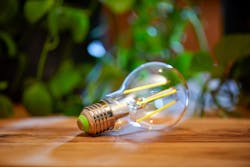Annual improvements in LED bulb efficiency entered the realm of marginal some time ago. But Signify jolted that inertia today, announcing at least a 60% leap on four new bulbs compared to its existing line, although it seems to have compromised somewhat on color temperature.
Signify is also claiming a lifetime of 50 years — more than three times longer than previous models.
The new “Philips LED A-class” white LED bulbs will hit the shelves in Europe on Sept. 1 in 40W and 60W equivalent versions, each available in 3000K or a cooler 4000K version, delivering at least 210 lm/W. Signify is labeling them as “ultra efficient.”
At 3000K and 4000K, the bulb will not deliver the warmth of the 2700K “warm white” models in Signify’s existing line or of the 2300K that some vendors claim (remember, in the counterintuitive Kelvin temperature scale, lower numbers are warmer; 2300K is tantamount to the warmth of an incandescent bulb, although K ratings are debatable, according to some industry insiders).
Without directly addressing the color temperature, Signify did tell LEDs Magazine that it did not cut corners, after we asked if the company in any way compromised on flicker or light quality.
“No, this product is designed with the high quality standards of Signify,” Kristof Vermeersch, head of global product management LED for bulbs, candles, spots, and switches told us via e-mail. “This product contains our EyeComfort promise — high quality LED light that is comfortable for the eyes — complying with 8 different criteria.” The criteria include flicker, color rendering, and glare, among others, but do not specifically include color temperature.
Vermeersch did claim that in northwestern Europe there has been a trend in general away from 2700K to 3000K, and pointed out that consumers in sunny southern Europe prefer 4000K, a color temperature that corresponds more to the cooler Kelvin light of sunny days.
“Signify has developed and designed four regular A-shape light bulbs that...consume 60% less power to achieve the same light output and quality as standard Philips LED bulbs,” Signify said in a press release.
The “60%” might be a conservative quantification. LEDs Magazine asked the company to provide a like-for-like comparison of a new model with an existing one. Veermeersch noted that a 5.5W standard Philips model delivers 85 lm/W for a total of 470 lm, while the new ultra-efficient model is rated at 2.3W, delivering 210 lm/W for a total of 485 lm.
In this case, the company is basing the 60% improvement on the power rating. The new lamp delivers 485 lm with an input of 2.3W, which is roughly 60% less than the 5.5W on the standard bulb, and slightly more lumen output as well.
We pointed out that the leap to 210 lm/W from 85 lm/W was far greater than 60%.
“That is correct for this example.,” the company replied. “This example is a 40W equivalent. For the 60W, we have at least a benefit of 60% energy saving, depending on which generation or value proposition (entry vs. premium) you compare. We chose in our commercial claim to take the ‘lowest’ benefit to make sure we don’t mislead any customer.”
The new bulbs are rated to last for 50,000 hours, compared to 15,000 hours for existing products in Signify’s Philips LED lamp portfolio. At 50,000 hours, a bulb should have “an average lifetime of 50 years,” Signify said.
Vermeersch declined to say how Signify achieved the improvements. We asked if the gains came via improvements on the chip level, bulb level, and/or perhaps in the driver.
“It is a combination of multiple elements,” Vermeersch replied, noting that for competitive reasons he could not reveal more. He confirmed that driver advances did play a role.
The choice of clear glass bulbs using a filament design, rather than using plastic covers over surface-mounted diodes (SMD) also helped, as Vermeersch noted that “filament supports better efficiency than SMD.” He added, “In Europe we see the trend is for glass bulbs and this has been prevalent for years, mainly because the look and feel is most familiar with the popular Incandescent or halogen bulbs of the past.”
The great leap in efficiency and longevity does come at a cost for the consumer. Signify priced the new bulbs at €8.99 for the 40W models and €9.99 for the two 60W versions. “The recommended retailer price will be around 2.5 times the comparable Philips alternative LED bulb, but still very affordable and cost efficient,” Vermeersch said. “It really is kind to the planet and your pocket.”
A big motivation for introducing the bulbs now is that they coincide with the beginning of tougher EU regulations on eco ratings. Beginning Sept. 1, the EU is replacing tiers that ran from A++ down to A+ and A through D. In that rating system, A++ required 120 lm/W, A+ has been 65 lm/W, A has been 50 lm/W, all bottoming out at E’s 0 lm/W.
The new system makes “A” the top rating, at 210 lm/w. It does away with the A++ and A+ categories, but instead runs down from A through G’s 0 lm/W. In the new listing, B will require 185 lm/W and C 160 lm/W.
Under the more stringent ratings, much of Signify’s existing line, which has been rated either A++ or A+, will tumble to class E or F. In the new system, E bulbs are rated at 110 lm/W, and F at 85 lm/W.
“Over time, we intend to expand (the new) product family, expanding our ranges under the A-class labeling in the coming years,” Vermeersch told LEDs.
Signify has not set a timetable for offering the ultra-efficient models in other countries.
MARK HALPER is a contributing editor for LEDs Magazine, and an energy, technology, and business journalist ([email protected]).
For up-to-the-minute LED and SSL updates, why not follow us on Twitter? You’ll find curated content and commentary, as well as information on industry events, webcasts, and surveys on our LinkedIn Company Page and our Facebook page.





